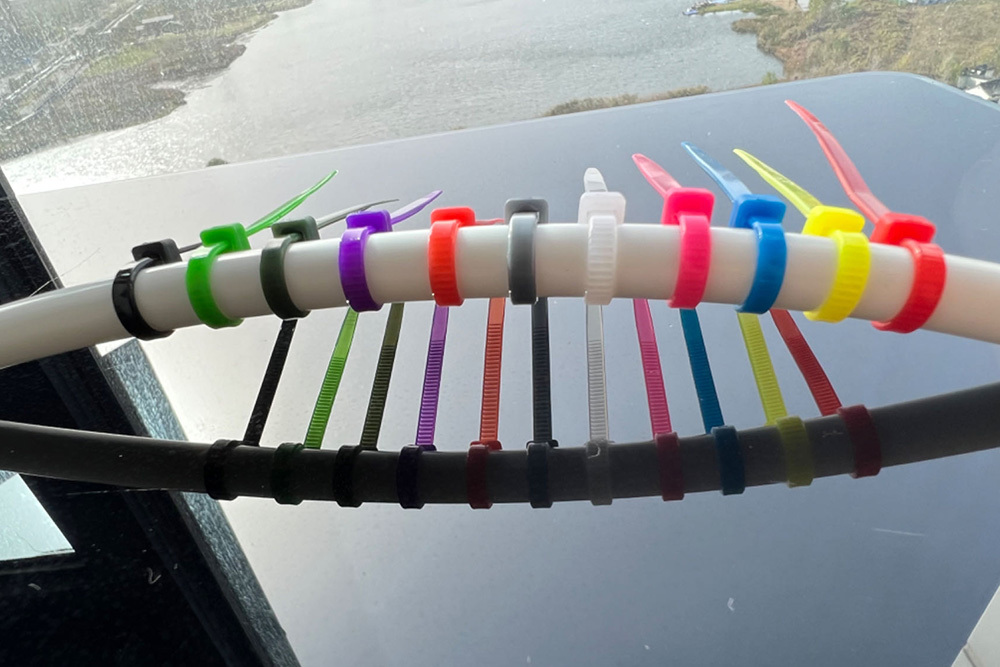13
2025
-
11
The environmentally friendly features of halogen-free plastic cable ties
Author:
Environmental Advantages of Halogen-Free Plastic Cable Ties
Reduced Environmental Pollution Risks
Traditional plastic cable ties often incorporate halogen-based flame retardants such as chlorine and bromine to enhance fire resistance. However, these halogenated compounds pose significant environmental threats. When exposed to high temperatures during combustion or disposal, halogenated materials release toxic gases like hydrogen chloride (HCl) and hydrogen bromide (HBr), which contribute to air pollution and acid rain formation. These gases also react with moisture in the atmosphere to form corrosive substances that degrade infrastructure and harm ecosystems.
In contrast, halogen-free plastic cable ties eliminate these risks by using non-halogenated flame retardants such as phosphorus-based compounds or metal hydroxides. These alternatives decompose into non-toxic byproducts during combustion, including water vapor and carbon dioxide, which have minimal environmental impact. Studies indicate that replacing halogenated flame retardants with halogen-free alternatives can reduce toxic gas emissions by up to 90% during fire scenarios, making them a safer choice for both indoor and outdoor applications.
Compliance with Global Environmental Regulations
The adoption of halogen-free plastic cable ties aligns with stringent international environmental standards designed to protect human health and ecosystems. Key regulations include the Restriction of Hazardous Substances (RoHS) Directive in the European Union, which limits the use of specific hazardous materials in electrical and electronic equipment, including halogens. Similarly, the Registration, Evaluation, Authorisation and Restriction of Chemicals (REACH) regulation enforces strict controls on chemical substances to ensure their safe use across industries.
Halogen-free formulations also meet the requirements of the International Electrotechnical Commission (IEC) standards, such as IEC 61249-2-21, which specifies limits for halogen content in printed circuit board materials. By adhering to these regulations, manufacturers of halogen-free plastic cable ties demonstrate their commitment to environmental responsibility and facilitate compliance for end-users in regulated markets. This regulatory alignment reduces the risk of legal penalties and enhances market access for products used in sensitive applications like medical devices, automotive components, and consumer electronics.
Enhanced Safety During Fire Incidents
Beyond environmental benefits, halogen-free plastic cable ties offer superior safety performance in fire emergencies. Halogenated materials generate dense smoke when burned, which reduces visibility and impedes evacuation efforts. The toxic gases released by halogenated compounds can also cause respiratory distress, disorientation, and even fatalities in confined spaces. For example, hydrogen chloride gas irritates the eyes, nose, and throat, while hydrogen bromide can lead to chemical burns and pulmonary edema.
Halogen-free alternatives address these concerns by producing significantly less smoke and non-toxic gases during combustion. Phosphorus-based flame retardants, for instance, promote char formation, which acts as a thermal barrier and reduces smoke generation. Metal hydroxides like magnesium hydroxide release water vapor when heated, which dilutes flammable gases and suppresses fire spread. These properties make halogen-free plastic cable ties ideal for applications where fire safety is critical, such as public transportation systems, data centers, and high-rise buildings.
Support for Sustainable Material Lifecycle Management
The lifecycle of halogen-free plastic cable ties contributes to broader sustainability goals by enabling cleaner production, use, and disposal processes. During manufacturing, halogen-free formulations often require lower processing temperatures compared to halogenated counterparts, reducing energy consumption and greenhouse gas emissions. The absence of halogenated additives also simplifies waste management, as halogen-free materials are less likely to contaminate recycling streams or incineration facilities.
At the end of their service life, halogen-free plastic cable ties can be recycled more efficiently than halogenated alternatives. Recycling facilities can process non-halogenated materials without the need for specialized equipment to handle toxic byproducts, lowering operational costs and environmental risks. Additionally, the biodegradability of certain halogen-free flame retardants, such as plant-based phosphorus compounds, further reduces their long-term environmental footprint. By choosing halogen-free options, industries can align with circular economy principles and minimize their reliance on finite resources.
Versatility Across Diverse Applications
The environmental and safety advantages of halogen-free plastic cable ties make them suitable for a wide range of industries and environments. In the electronics sector, these cable ties are used to secure wiring harnesses in devices like smartphones, laptops, and servers, where compliance with RoHS and REACH is mandatory. The automotive industry relies on halogen-free cable ties for engine compartments, battery packs, and interior components, where fire resistance and low toxicity are essential for passenger safety.
Construction and infrastructure projects also benefit from halogen-free solutions, particularly in buildings with stringent fire codes. These cable ties are used to organize electrical cables in plenum spaces, where smoke generation must be minimized to prevent fire propagation. In renewable energy applications, such as solar panel installations and wind turbine assemblies, halogen-free cable ties withstand harsh weather conditions while maintaining their environmental integrity. Their versatility ensures that industries can meet regulatory requirements without compromising performance or sustainability.
plastic cable ties
Hot News
2025-11-13
The environmentally friendly features of halogen-free plastic cable ties
Traditional plastic cable ties often incorporate halogen-based flame retardants such as chlorine and bromine to enhance fire resistance. However, these halogenated compounds pose significant environmental threats.
2025-11-13
The anti-aging principle of UV-resistant plastic cable ties
Plastic cable ties, particularly those made from polyamide (PA66), are widely used in outdoor and industrial environments where exposure to ultraviolet (UV) radiation is inevitable.
2025-11-12
Application of high-temperature resistant PEEK plastic cable ties
In industries where extreme temperatures and corrosive environments are routine, selecting materials that maintain structural integrity under such conditions is critical. PEEK (Polyether Ether Ketone) plastic cable ties have emerged as a superior solution due to their exceptional heat resistance, chemical stability, and mechanical strength. This article explores their applications across high-demand sectors and the technical advantages that make them indispensable.
2025-11-12
Chemical stability of PTFE plastic cable ties
In industrial environments where exposure to aggressive chemicals is routine, selecting materials with superior chemical resistance is non-negotiable. PTFE (Polytetrafluoroethylene) plastic cable ties emerge as a premier solution due to their unparalleled ability to withstand corrosive substances while maintaining structural integrity.

